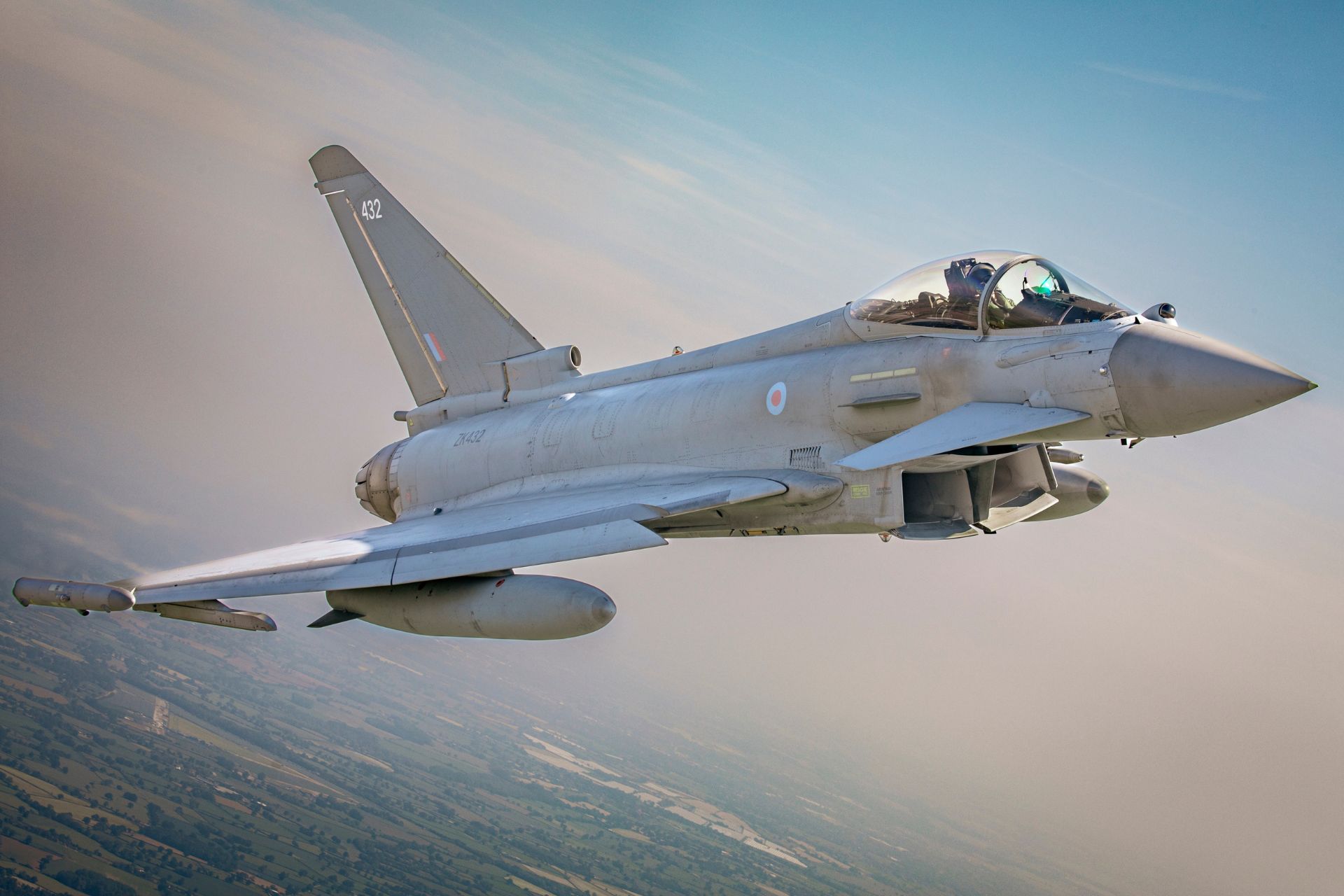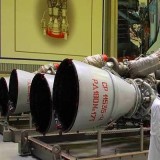British Aerospace Industry at Stake with Choice Between Typhoon and F-35A Fighter Jets

{loadposition bannertop}
{loadposition sidebarpub}
As the British government prepares to announce its decision on the purchase of new combat aircraft for the Royal Air Force, the Unite union is urging the Ministry of Defence to prioritize national production by opting for additional Typhoon jets over F-35As. According to Unite, this decision is crucial for safeguarding the UK’s industrial expertise and preparing the country for the production of the future sixth-generation combat air program, known as Tempest or the Global Combat Air Programme (GCAP).
Follow Army Recognition on Google News at this link
The Typhoon would support industrial autonomy and preserve national expertise while remaining a proven, versatile tool for diverse missions. (Picture source: British MoD)
As the British government prepares to announce its decision on the purchase of new combat aircraft for the Royal Air Force, the Unite union is urging the Ministry of Defence to prioritize Eurofighter Typhoon jets over the F-35A. This decision is deemed crucial for safeguarding national industrial expertise and preparing the UK for the production of the future sixth-generation fighter program, the Tempest, or the Global Combat Air Programme (GCAP). With large-scale production of Tempest expected in the 2030s, the gradual reduction of the UK Typhoon production line threatens the industrial base, including the 6,500 BAE Systems employees currently involved in the program.
A recent report by the Defence Select Committee further underscores the strategic importance of preserving jobs and expertise in the aerospace sector. The Eurofighter Typhoon, developed by a European consortium comprising EADS, Alenia Aeronautica, and BAE Systems, is a highly versatile multirole aircraft. It excels in air superiority, ground strikes, reconnaissance, and maritime attack. With a maximum speed of 2,495 km/h, exceptional agility, and 13 hardpoints for various armaments such as AMRAAM missiles, Paveway guided bombs, and Storm Shadow anti-radar missiles, it is well-suited for a broad range of missions. Its CAPTOR-M radar, combined with a planned upgrade to AESA technology, enhances detection and targeting capabilities, while its lightweight composite structure ensures operational flexibility.
In contrast, the F-35A Lightning II, developed by Lockheed Martin under the Joint Strike Fighter program, emphasizes stealth and advanced technology. Its AESA AN/APG-81 radar and Distributed Aperture System (DAS) provide unmatched situational awareness, supported by advanced electronic warfare capabilities. Designed to operate in heavily defended airspaces, the F-35A can carry a range of weapons, including AMRAAM missiles, JDAM bombs, and HARM missiles, all while maintaining a low radar signature through its internal weapons bay. While it has a lower top speed (1,930 km/h compared to 2,495 km/h) and slightly less agility, the F-35A’s ability to neutralize advanced air defense systems and its integration into coalition operations make it a strategically valuable asset.
In terms of costs, the Typhoon presents significant advantages for the British economy. A purchase of 24 aircraft could sustain 26,000 jobs over two years across BAE Systems, Rolls-Royce, Leonardo, and the broader national supply chain. By comparison, a similar order for the F-35A would create only two to three months of work for approximately 2,000 workers in the UK. While the Typhoon directly supports local industry, the F-35A benefits from economies of scale due to its large-scale production, potentially offsetting its higher initial costs. However, the infrastructure required to maintain its stealth technology adds significant long-term expenses.
The choice between the two aircraft depends on the UK’s strategic priorities. The Typhoon would support industrial autonomy and preserve national expertise while remaining a proven, versatile tool for diverse missions. Meanwhile, the F-35A, with its stealth and advanced capabilities, is better suited to modern conflicts involving contested environments. A hybrid solution combining both aircraft could offer a strategic balance, addressing immediate military needs while supporting the long-term viability of the national aerospace sector.
Unite emphasizes the urgency of this decision. General Secretary Sharon Graham highlighted the importance of retaining the highly skilled engineers and technicians in the aerospace sector. She called on the government to invest in Typhoons to meet military and economic needs while ensuring continuity of expertise for future programs. Rhys McCarthy, Unite’s national defense officer, warned that neglecting the domestic defense industry in an increasingly unstable world would be irresponsible. He also stressed that the UK government cannot expect to sell Typhoons abroad if it does not demonstrate confidence in the product itself.
The decision between the Typhoon and the F-35A represents a critical strategic choice for the UK. Beyond military considerations, it could redefine the future of the national aerospace industry while addressing global security challenges.

{loadposition bannertop}
{loadposition sidebarpub}
As the British government prepares to announce its decision on the purchase of new combat aircraft for the Royal Air Force, the Unite union is urging the Ministry of Defence to prioritize national production by opting for additional Typhoon jets over F-35As. According to Unite, this decision is crucial for safeguarding the UK’s industrial expertise and preparing the country for the production of the future sixth-generation combat air program, known as Tempest or the Global Combat Air Programme (GCAP).
The Typhoon would support industrial autonomy and preserve national expertise while remaining a proven, versatile tool for diverse missions. (Picture source: British MoD)
As the British government prepares to announce its decision on the purchase of new combat aircraft for the Royal Air Force, the Unite union is urging the Ministry of Defence to prioritize Eurofighter Typhoon jets over the F-35A. This decision is deemed crucial for safeguarding national industrial expertise and preparing the UK for the production of the future sixth-generation fighter program, the Tempest, or the Global Combat Air Programme (GCAP). With large-scale production of Tempest expected in the 2030s, the gradual reduction of the UK Typhoon production line threatens the industrial base, including the 6,500 BAE Systems employees currently involved in the program.
A recent report by the Defence Select Committee further underscores the strategic importance of preserving jobs and expertise in the aerospace sector. The Eurofighter Typhoon, developed by a European consortium comprising EADS, Alenia Aeronautica, and BAE Systems, is a highly versatile multirole aircraft. It excels in air superiority, ground strikes, reconnaissance, and maritime attack. With a maximum speed of 2,495 km/h, exceptional agility, and 13 hardpoints for various armaments such as AMRAAM missiles, Paveway guided bombs, and Storm Shadow anti-radar missiles, it is well-suited for a broad range of missions. Its CAPTOR-M radar, combined with a planned upgrade to AESA technology, enhances detection and targeting capabilities, while its lightweight composite structure ensures operational flexibility.
In contrast, the F-35A Lightning II, developed by Lockheed Martin under the Joint Strike Fighter program, emphasizes stealth and advanced technology. Its AESA AN/APG-81 radar and Distributed Aperture System (DAS) provide unmatched situational awareness, supported by advanced electronic warfare capabilities. Designed to operate in heavily defended airspaces, the F-35A can carry a range of weapons, including AMRAAM missiles, JDAM bombs, and HARM missiles, all while maintaining a low radar signature through its internal weapons bay. While it has a lower top speed (1,930 km/h compared to 2,495 km/h) and slightly less agility, the F-35A’s ability to neutralize advanced air defense systems and its integration into coalition operations make it a strategically valuable asset.
In terms of costs, the Typhoon presents significant advantages for the British economy. A purchase of 24 aircraft could sustain 26,000 jobs over two years across BAE Systems, Rolls-Royce, Leonardo, and the broader national supply chain. By comparison, a similar order for the F-35A would create only two to three months of work for approximately 2,000 workers in the UK. While the Typhoon directly supports local industry, the F-35A benefits from economies of scale due to its large-scale production, potentially offsetting its higher initial costs. However, the infrastructure required to maintain its stealth technology adds significant long-term expenses.
The choice between the two aircraft depends on the UK’s strategic priorities. The Typhoon would support industrial autonomy and preserve national expertise while remaining a proven, versatile tool for diverse missions. Meanwhile, the F-35A, with its stealth and advanced capabilities, is better suited to modern conflicts involving contested environments. A hybrid solution combining both aircraft could offer a strategic balance, addressing immediate military needs while supporting the long-term viability of the national aerospace sector.
Unite emphasizes the urgency of this decision. General Secretary Sharon Graham highlighted the importance of retaining the highly skilled engineers and technicians in the aerospace sector. She called on the government to invest in Typhoons to meet military and economic needs while ensuring continuity of expertise for future programs. Rhys McCarthy, Unite’s national defense officer, warned that neglecting the domestic defense industry in an increasingly unstable world would be irresponsible. He also stressed that the UK government cannot expect to sell Typhoons abroad if it does not demonstrate confidence in the product itself.
The decision between the Typhoon and the F-35A represents a critical strategic choice for the UK. Beyond military considerations, it could redefine the future of the national aerospace industry while addressing global security challenges.





